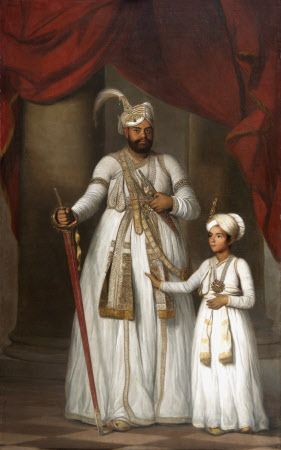Prince Azim-ud-Daula, Nawab of the Carnatic (1775 - 1819), and his Son, Azam Jah (1800 - 1825)
Thomas Hickey (Dublin 1741 – Madras 1824)
Category
Art / Oil paintings
Date
1803 (signed and dated)
Materials
Oil on canvas
Measurements
2362 x 1448 mm (93 x 57 in)
Order this imageCollection
Powis Castle and Garden, Powys
NT 1180953
Caption
Azim-ud-Daula was Nawab of the Carnatic region of India from 1801 until his death in 1819. The title ‘Nawab’ was bestowed by the Mughal Emperor upon princely Muslim rulers and can be best understood, perhaps, as a similar distinction to a British peerage. The primary duty of a Nawab was to uphold the sovereignty of the Mughal Emperor along with the administration of a certain province. The artist who painted this portrait, Thomas Hickey, was born in Dublin but spent much of his career travelling around Asia, particularly in India. He gained most of his commissions from members of the British East India Company and their Indian allies.
Summary
Oil painting on canvas, Prince Azim-ud-Daula, Nawab of the Carnatic (1775 - 1819), and his Son, Azam Jah (1797 - 1825) by Thomas Hickey (Dublin 1741 – Madras 1824), inscribed on the reverse and signed and dated Thomas Hickey pinxit 1803. Full-length portraits of the Nawab standing with his sword in his right hand and his son standing to his left, holding the edge of his father's robe with his right hand. Azim-ud-daula, the son of Amir-ul-Umara, succeeded his uncle Umdat-ul-Umara as Nawab of the Carnatic (also known as Arcot) in 1801 and reigned until 1819. In 1801 Azim-ud-Daula signed the Carnatic Treaty, ceding his lands and governing authority to the British East India Company in return for British support as titular ruler. This is one of the portraits produced by the Irish artist Thomas Hickey during his second visit to India. When the 2nd Baron Clive retired as Governor of Madras in 1803 he brought the portrait home to Powis. A copy was made by Thomas Day in 1820 at the request of the EIC and given to the Nawab of the Carnatic; it is now at Fort St George Museum, Madras. See also NT 1180967, a half-length of Azim-ud-Daula.
Provenance
Painted for the sitter in 1801-3, but presented by him to the 2nd Lord Clive (afterwards 1st Earl of Powis) on his relinquishing the appointment of Governor of Madras in 1803. Brought to Powis Castle from Walcot Hall in 1930. Accepted by HM Treasury on 21st March, 1963 in lieu of tax and conveyed to National Trust ownership on 29th November 1963.
Credit line
Powis Castle, The Powis Collection (National Trust)
Marks and inscriptions
Reverse: Thomas Hickey pinxit 1803
Makers and roles
Thomas Hickey (Dublin 1741 – Madras 1824), artist
References
Foster 1930-31 Sir William Foster, ‘British Artists in India, 1760-1820’, Walpole Society, XIX, 1930-31, pp.14, 37 Steegman 1957 John Steegman, A Survey of Portraits in Welsh Houses, Vol.I: North Wales, Cardiff, 1957, no. 66 Archer 1979 Mildred Archer, India and British Portraiture 1770-1825, 1979, p. 228, pl.155 & p. 502 Bayly 1990: C.A. Bayly (ed.), The Raj, India and the British 1600-1947,exh.cat. National Portrait Gallery, London, 1990-91, no. 144, pp. 121-22
